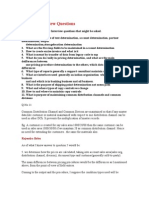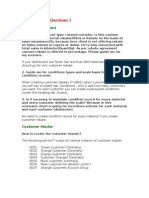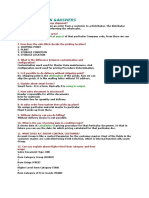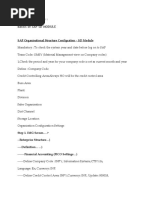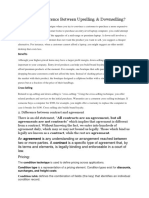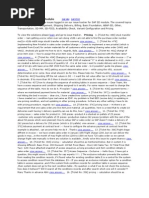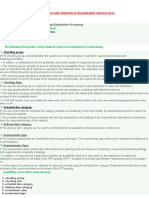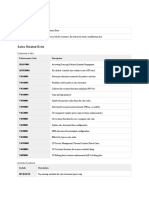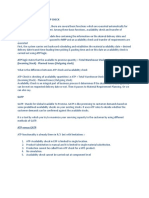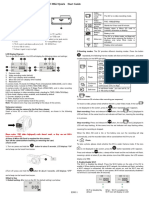Sap SD Short Qna
Sap SD Short Qna
Uploaded by
Charles IesmatauwCopyright:
Available Formats
Sap SD Short Qna
Sap SD Short Qna
Uploaded by
Charles IesmatauwOriginal Title
Copyright
Available Formats
Share this document
Did you find this document useful?
Is this content inappropriate?
Copyright:
Available Formats
Sap SD Short Qna
Sap SD Short Qna
Uploaded by
Charles IesmatauwCopyright:
Available Formats
Rebate Agreement
1. Which agreement type I should consider, is this customer rebate(0003), material rebate(0002) or Rebate on the basis of sales volume(0005), because here client is not offering rebate on Sales volume in rupees or dollar. He is only concerned with total sales in kiloliter(Quantity). As per rebate agreement concern rebate is offered in percentage. Please guide me for my scenario. If your distributors are fewer (far less than 900 materials) then you should go for only customer rebate. 2. Guide me for conditions types and scale basis for maintaining condition records. When creating customer rebates (T:VB01) select customer rebate, there you will see a header tab: Conditions , click it add how many customers you want. For each customer you can create scale based conditions (under the heading tab :Scales). 3. Is it necessary to maintain condition record for every material and every customer defining the scale? Because in this scenario client is going for incentives scheme for each material and each customer (distributor). No need to create condition record for every material if you create customer rebate.
Customer Master
How to create the customer master? The following are the T-codes for central creation of customer master. XD01 XD02 XD03 XD04 XD05 XD06 XD07 XD99 XDN1 Create Customer (Centrally) Change Customer (Centrally) Display Customer (Centrally) Customer Changes (Centrally) Block customer (centrally) Mark customer for deletion (centr.) Change Customer Account Group Customer master mass maintenance Maintain Number Ranges (Customer)
You need to identify various parameters within each Account group based on which the reco account is identified within the customer master. Customer master is basically divided into 3 tabs. - General - General master details, Juristiction codes, Region, Transportation zone, export data, etc. - Company data - payment terms, account management, reco account, insurance etc. - Sales data - Sales product attributes, sales office, sales group, customer pricing procedure, Cust. Statistical grp, - Shipping data - Billing data - Partner functions. You can create a customer based on 3 views: 1. For Account purpose
FD01/FD02/FD03 etc 2. Sales purpose XD01/XD02/XD03 etc. 3. Centrally VD01/VD02/VD03 etc. What is the Function of item category and item category group? Item Category determines the processing of any Item/material that we enter in a sales order and in this way it also effects the procesing of any sales doc in which it is used. Item Category Group is one of the component which along with the Sales Doc Type, The Item Usage and Higher Level Item Category decide about the Item Category in a sales doc. 1. How can we know whether the customer is one-time or regular? One can maintain Account Group for One-time customers. By which we can identify one-time customers. 2. What happens when you do not enter a value for a manual and mandatory condition type? The pricing procedure will reject the conditions in the sales order 3. Do header condition type have an access sequence? No 4. Org structure: Relation between Company - Sales org One-to-Many Sales Org - Plants & company vs. Plants Company - sales org - credit control area What are sales area and its components? Sales area consists of Sales Organisation, Distribution Channel and Division. 5. What are legacy systems? The Existing system on which current system is working, from which the current system will be migrated to SAP system 6. What is cut over strategy? Cutover strategy depends upon how the organizations design their data load strategies. Normally, you decide the sequence of Data loads for Configuration settings, Master data, Transaction data which follows whom and then you make a copy of the system as a Production system a day before and after checking the successful data loads, you go-live 100% or partial again depending upon organizational setup and policies. Cutover planning is highly site specific. There's no thumb rule. The stock data as on the date of going live should be correctly entered. But stock being a highly dynamic quantity, the strategy for loading should be crystal clear. Then you have to load all the back dated transaction on the stock. Some stock comes into your
plant/storage location as return and some stock is actually delivered to your customer through sales orders of various kinds. 7. What are Cumulative Condition Records? There is a field:- "condition update" during configuration for a condition type (at v/06)... has it anything to do with cumulative condn. Records? 8. IF you have 3 different access sequences for one condition record then in a pricing procedure in what hierarchy will you maintain the three accesses? In Condition Records (T Code VK11), you would be putting values to corresponding Condition Types. Now one Condition Type can be assigned to one access sequence. In Access Sequence, you can assign whichever tables and fields are required. So in my opinion, you cannot have one condition record for 3 access sequences. 9. What happens in the access sequence when you put all the ticks in the exclusive field? When you put tick in exclusive field of all access sequences, in my opinion, it will try to get available data from the first. Only in case, data is not available, will it move on to the next one. 10. What is meant by delivery group? Delivery Group is basically grouping all individual deliveries for Billing. It should have the same Ship to Party, Shipping Point, etc. 11. What triggers the automatic creation of PR or PO in case of third party sales? In item category we can set "automatic PO" so that PO and PR will automatically generate after saving the order. You never change the item category configuration to "automatic PO". It is the schedule line category type which triggers the automatic PR creation. 12. What are the steps that are required to include sales person as a partner function in the partner determination? Partner function sales represenative or person responsible these two we can add through partner funtion in partner procedure. 13. What is z transaction? We copied standard TC or object and rename it by Z its basically stnd name which will start from Z (User defined) 14. Can you create sales order for 40 items if the quotation is sent for 30 items? Yes. 15. What is the importance of requirment field in access sequence?
System will not go to asscess condition type system will reply through formula. 16. What makes the immediate delivery in cash sales? Order type immediate delivery switch on. 1. What is change request and task? What was your task no.? I need an example or a task no. that is being used in your project to clear few things in my mind? The Change Request is that request when you do some thing new in customizing or configuration in the system. The system will automatically pop with the change request pop box , when you can give request name as defined by the system or can give your own request name with heading of what changes you have made while customization. The system will generate a request number and you save it. (e.g.:- VEDK-2785467) VEDKmeans the Clients System name then followed by the system generated request number. Now when you want to release the request you have to use the T-code SE10 where you can see the requests under the heading modifiable or released. Go to the modifiable option. Each request will have again an internal request number. First you have to release the internal request and then release the external request number. This will in turn released by the basis guys thru the T-code SM64 in a group when all the requests are pooled from different users. The task which you have mentioned in your question is nothing but the what task you have performed while customizing the client system and the heading name which have given it for that task and generated a request for that task. 2. What is your client Number in the project? Like how we have 800 for IDES? Generally like IDES client, when you are in the project, the client is also given a number called client number. So while implementing a project The entire implementation is done under phases and in different Client no Servers. e.g.:-take a company called ABC which is implementing SAP. So the Client is given a number in the following manner by the SAP Implementers at the site 291- Sand Box server (Initial Testing scenarios Server) 292- Development Sever (With client data of minimum 15 days transactions) 294- Testing Server (the scenarios developed in development server is tested here) 295- Golden Master Server (Quality cum Testing Server) - checked finally before transferring to production server 296- Production Server (where the clients live data is stored and daily business transactions are done) 3. Few client requirements for customer master, material master, Organization and Transactions. The client requirements may be in the form of customized reports and queries which are supposed to be suited according to their business process. Generally the requirements would be coming from the BPO's (Business Process Owners) who will deputed for each module e.g.:- SD, PP QM FI) by the client as they would be expert in their areas and module who under the business processes as they clients Project Team members. They are whole and sole responsible to get the implementation done and meet the requirements raised by them and the other users from the clients side.
Generally before starting the implementation the entire organization structure and the organizational elements are freezed and a skeleton structure is prepared and then along with BPO's requirements the system is 1st configured and then the customization is started to suit the Clients specified requirements. Now as far as the transactions are concerned not all the users are allowed to run all the transactions. Here the user roles are defined as per the BPO's (i.e., the user is given authorization only to run certain transactions depending on the levels and stages in his area of specialization like in SD module the entry level user is only allowed to enter the data like creation of Sales orders or delivery and billing and the next level is give the authorization for changes to be made for that same data that is entered by the entry level users. The next higher level -Supervisor is given a few more transaction authorization which will be above these mentioned users) Here the reports are segregated like Higher Management Reports, Middle Management Reports where by again authorization is given those heads(Head of the Depts. or the Plants heads or GM etc.,) to run certain transactions which allow to view reports that are needed daily by the management. SAP SD Tips by: Moyin 4. How to restrict users for not changing some fields in T-code va02? There are two ways to do this: - Make a transaction variant thru SHD0 and assign it to your sales doc. While creating the variant you can place non-changeability ticks on specific fields. Next allow those users only to work with your transaction variant but not with the original transaction. - You could make use of user-exit FORM USEREXIT_FIELD_MODIFICATION in include MV45AFZZ (via authorization objects, which you can assign in role customizing). The latter is more flexible but it is not feasible if you want to place restrictions to a large amount of fields. *-Sabir 5. How can we delete the Sales Orders? How can an invoice be cancelled or deleted? You can very well delete sales order using transaction VA02, but with a constraint that no subsequent document is created against it. Invoice can be cancelled using T cose VF11 and then you can reverse the Goods Issue using VL09 and making the picking quantity zero in the deivery document and delete the delivery order using VL02n . You can then delete the sales order then. *-- Vaibhav You cannot delete an Invoice. You can only cancel it with (VF11) if the relevant accounting document is not been generated. Ask your FI guy to reverse the accounting doc. Only after the accounting doc is reversed and/or deleted, you can cancel your invoice. You also need to check if any TAX documents are generated with your Invoice. You need to reverse/delete those documents also. *-- Ganeshan.D
You might also like
- Diagramas Eléctricos Nissan Sentra 1.8l 4 Cil (Qg18de) 2006 - 100938Document59 pagesDiagramas Eléctricos Nissan Sentra 1.8l 4 Cil (Qg18de) 2006 - 100938Sandor Moran100% (3)
- SAP S/4HANA Retail: Processes, Functions, CustomisingFrom EverandSAP S/4HANA Retail: Processes, Functions, CustomisingRating: 2 out of 5 stars2/5 (2)
- The Up & Away Advisors’ Guide to Implementing and Executing Sap’s Vehicle Management SystemFrom EverandThe Up & Away Advisors’ Guide to Implementing and Executing Sap’s Vehicle Management SystemNo ratings yet
- GCP Cloud Digital Leader SlidesDocument199 pagesGCP Cloud Digital Leader SlidesaspjcarlosjrNo ratings yet
- SD TicketsDocument2 pagesSD TicketsSUDHIRNo ratings yet
- Imp. Live Tickets 1Document9 pagesImp. Live Tickets 1sham_20febNo ratings yet
- Batch Management From SAP SD PointDocument9 pagesBatch Management From SAP SD PointnabigcsNo ratings yet
- SD Certification GuideDocument142 pagesSD Certification GuideMario SanchezNo ratings yet
- 300+ TOP Sap SD Interview Questions and Answers 2022Document23 pages300+ TOP Sap SD Interview Questions and Answers 2022saurabhkothawade144No ratings yet
- SAP SD Interview Questions: Rajendra BabuDocument4 pagesSAP SD Interview Questions: Rajendra Babusyed hyder ALINo ratings yet
- Short SAP SD Questions 1Document36 pagesShort SAP SD Questions 1srilekha02No ratings yet
- SAP SD Interview QuestionsDocument10 pagesSAP SD Interview QuestionsPrasad BudhwaniNo ratings yet
- Sap SD Interview QuestionsDocument0 pagesSap SD Interview QuestionsSA130974No ratings yet
- Sap SD Question &answers: Geographical Aspect Generate The ReportsDocument16 pagesSap SD Question &answers: Geographical Aspect Generate The Reportsk mahesh100% (1)
- Real Time Tickets in SAP SD: 1) Billing Document Not Released To Accounting / Accounts DeterminationDocument3 pagesReal Time Tickets in SAP SD: 1) Billing Document Not Released To Accounting / Accounts DeterminationPallavi SolaseNo ratings yet
- SAP SD OverviewDocument133 pagesSAP SD OverviewBhaskar Biswas100% (1)
- SAP SD Frequently Asked Questions - ERP Operations - SCN WikiDocument6 pagesSAP SD Frequently Asked Questions - ERP Operations - SCN WikiNeeraj JainNo ratings yet
- Partner Determination ProcedureDocument9 pagesPartner Determination ProcedureyaseennawazNo ratings yet
- Fundamentals of SAP SD PricingDocument13 pagesFundamentals of SAP SD PricingAnil SharmaNo ratings yet
- SD AssignmentDocument14 pagesSD AssignmentNaveen Kumar100% (1)
- Credit Management - Part OneDocument22 pagesCredit Management - Part Onearshad nadeemNo ratings yet
- Sap SD Faq'S: 1. Which T-Code Are Using For Customer Master?Document17 pagesSap SD Faq'S: 1. Which T-Code Are Using For Customer Master?venkatNo ratings yet
- Free Goods in SAP SDDocument1 pageFree Goods in SAP SDpraveennbsNo ratings yet
- SAP SD Enterprise StructureDocument7 pagesSAP SD Enterprise StructureLoganathanNo ratings yet
- SAP SD HCL InterviewDocument2 pagesSAP SD HCL InterviewGowtham ReddyNo ratings yet
- Important Tips For Interview For SAP SDDocument11 pagesImportant Tips For Interview For SAP SDvishal_sap84100% (1)
- Sap SD Interview QuesDocument32 pagesSap SD Interview QuesKiran Bharati0% (1)
- Basics of Sap SD ModuleDocument20 pagesBasics of Sap SD ModuleSourav Daruka100% (1)
- SAP QuestionsDocument15 pagesSAP Questionsramesh BNo ratings yet
- Deemed ExportDocument4 pagesDeemed ExportPrashanth ReddyNo ratings yet
- V of M Data Transfer RoutinesDocument28 pagesV of M Data Transfer RoutinesSamik Biswas100% (3)
- C TSCM62 67Document6 pagesC TSCM62 67陳厚宇100% (1)
- SAP SD Questions and AnswersDocument16 pagesSAP SD Questions and Answerserlend2012100% (1)
- ThirdPartySales SAP SDDocument14 pagesThirdPartySales SAP SDRaja ShekarNo ratings yet
- 23 Questions On SAP SD ShippingDocument4 pages23 Questions On SAP SD ShippingBalaji_SAPNo ratings yet
- What Is Condition Supplement and Why Is It UsedDocument3 pagesWhat Is Condition Supplement and Why Is It UsedRavinder Singh NegiNo ratings yet
- SAP SD Issues On SAP SD ModuleDocument33 pagesSAP SD Issues On SAP SD ModulerameshprustyNo ratings yet
- Sap SD - Basic Q & ADocument4 pagesSap SD - Basic Q & Ashekharsaseendran100% (1)
- Introduction To SAP SD Material MasterDocument20 pagesIntroduction To SAP SD Material MasterAJAY PALNo ratings yet
- Sap SDDocument71 pagesSap SDskumar4787No ratings yet
- RequirementsDocument174 pagesRequirementsSourav KumarNo ratings yet
- Sap SDDocument9 pagesSap SDSouvik_DasNo ratings yet
- Interview Questions For Sap SD PDFDocument50 pagesInterview Questions For Sap SD PDFRajan S PrasadNo ratings yet
- Field Description of Sales Item CategoryDocument23 pagesField Description of Sales Item CategoryvidyadharNo ratings yet
- Shipping Point Determination in SAP: Standard Output Types in SDDocument2 pagesShipping Point Determination in SAP: Standard Output Types in SDsoorya6969No ratings yet
- Reverse Pricing Procedure PDFDocument7 pagesReverse Pricing Procedure PDFpanirbanonline3426100% (18)
- Unit Test - SDDocument27 pagesUnit Test - SDMaga RosalesNo ratings yet
- SAP SD ResumeDocument3 pagesSAP SD ResumeGagandeep Singh RiarNo ratings yet
- Kofi and KofkDocument2 pagesKofi and KofkShyam Kumar MallisettyNo ratings yet
- Avalability Check and Transfer of Requirnment Process in SDDocument5 pagesAvalability Check and Transfer of Requirnment Process in SDShobhitNo ratings yet
- SD User ExitsDocument21 pagesSD User ExitsHuseyn IsmayilovNo ratings yet
- Availability Check and Atp CheckDocument4 pagesAvailability Check and Atp CheckyareddyNo ratings yet
- Learning SAP: SAP Tutorial - Background MaterialDocument25 pagesLearning SAP: SAP Tutorial - Background MaterialAnonymous 0wXXmp1No ratings yet
- SAP - SD - Third Party Sales ProcessDocument1 pageSAP - SD - Third Party Sales ProcessAnand100% (1)
- How SAP Pricing WorksDocument8 pagesHow SAP Pricing Worksjuan0% (1)
- Back Order ProcessDocument11 pagesBack Order ProcessManiJyotiNo ratings yet
- Userexits in Sap SD: User Exits in Sales Document ProcessingDocument10 pagesUserexits in Sap SD: User Exits in Sales Document ProcessingsumplerNo ratings yet
- Variable Speed Chillers With PicvDocument1 pageVariable Speed Chillers With PicvPradeep SukumaranNo ratings yet
- Experiment 4Document8 pagesExperiment 4Himanshu Rajan jainNo ratings yet
- Tga D3 800TVDocument1 pageTga D3 800TVJulian Andres VictoriaNo ratings yet
- SEE Electrical V7 Crack PDFDocument3 pagesSEE Electrical V7 Crack PDFValerieNo ratings yet
- GR 10 PAT IT Annexure Task 1 - 2024 EngDocument8 pagesGR 10 PAT IT Annexure Task 1 - 2024 EngLeanda OosthuizenNo ratings yet
- 1.introduction To Software Engineering-1Document11 pages1.introduction To Software Engineering-1Mohammed AnasNo ratings yet
- WiFi Smart Power Strip With Cayenne Cloud PDFDocument11 pagesWiFi Smart Power Strip With Cayenne Cloud PDFAlberto CorralesNo ratings yet
- CRB Whitepaper Vapor Hydrogen Peroxide Decontamination WebDocument8 pagesCRB Whitepaper Vapor Hydrogen Peroxide Decontamination WebVictor LeiNo ratings yet
- Softstarter Abb ProintsacDocument8 pagesSoftstarter Abb ProintsacRichard BertoniNo ratings yet
- Bulletin 937 Intrinsic Safety Modules: Specialized Solutions For Hazardous Location ApplicationsDocument4 pagesBulletin 937 Intrinsic Safety Modules: Specialized Solutions For Hazardous Location ApplicationsNixiusNo ratings yet
- Bronko Cover02Document10 pagesBronko Cover02gregoryNo ratings yet
- CourseworkDocument8 pagesCourseworkdungnagch220140No ratings yet
- Utility-Summary MINE EDITEDDocument1 pageUtility-Summary MINE EDITEDMichael J. BaneNo ratings yet
- I Robotricks PDFDocument2 pagesI Robotricks PDFtejashraj93No ratings yet
- Concept and Types of Foreign CollobarationsDocument6 pagesConcept and Types of Foreign CollobarationsYash PunjabiNo ratings yet
- Speedster™ Fpga Family: Product BriefDocument2 pagesSpeedster™ Fpga Family: Product BriefJessica ThompsonNo ratings yet
- System Hardware and Data HandlingDocument25 pagesSystem Hardware and Data HandlinghappymalamuziNo ratings yet
- Denver Ac-5000w Mk2 - EnglishDocument2 pagesDenver Ac-5000w Mk2 - EnglishPrva CetaNo ratings yet
- Dwm1001 System OverviewDocument42 pagesDwm1001 System Overviewfelixsafar3243No ratings yet
- Schneider Electric - Wiser-By-SE - CCT501900Document3 pagesSchneider Electric - Wiser-By-SE - CCT501900MJNo ratings yet
- Booklet On EEE Was Updating 2021 2 11bd31e17aDocument50 pagesBooklet On EEE Was Updating 2021 2 11bd31e17aMVLNo ratings yet
- Flex Power Guide 1.3.2Document191 pagesFlex Power Guide 1.3.2Guillermo García GándaraNo ratings yet
- Introducing Your New AT&T BillDocument2 pagesIntroducing Your New AT&T BillChloe0% (1)
- OS Unit 1Document42 pagesOS Unit 1lokeshpatil4889109No ratings yet
- QPAY Company PDFDocument15 pagesQPAY Company PDFBhasker NiftyNo ratings yet
- WT24Document22 pagesWT24Руслан НелюбінNo ratings yet
- Interactive MediaDocument10 pagesInteractive MediaSiti IzaniNo ratings yet
- TM4170 Point - T O-Point Plug-In Boar D: ApplicationsDocument2 pagesTM4170 Point - T O-Point Plug-In Boar D: ApplicationsTaranvir SinghNo ratings yet











